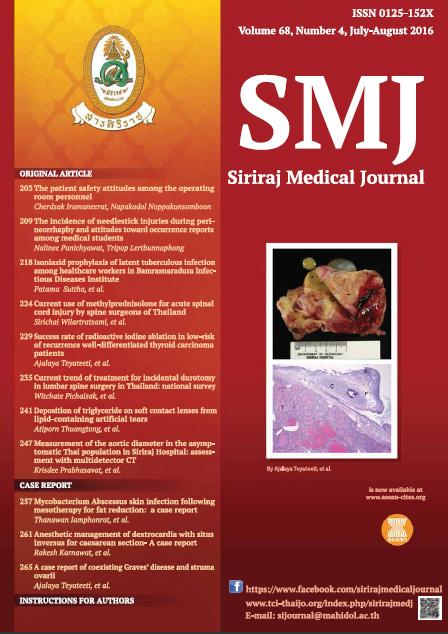Current Use of Methylprednisolone for Acute Spinal Cord Injury by Spine Surgeons of Thailand
Keywords:
Methylprednisolone, acute spinal cord injury, Thailand, surveyAbstract
Objective: To determine current decision making in methylprednisolone succinate (MPS) administration for acute spinal cord injury (ASCI) treatment in Thailand.
Methods:A questionnaire was sent to all orthopedic surgeons who attended the annual meeting of the Spine Society of Thailand 2016. The questionnaire had 3 parts of questions including demographic data, opinions in MPS use in general ASCI patients and patients who meet the exclusion criteria in NASCIS III study.
Results:Fifty-five respondents completed the survey (overall response rate was 27.1 %) and there was 78.18% prescribe MPS to ASCI patients. Among them, 40 % prescribe according to NASCIS II and 55.6% NASCIS III. The main reasons for MPS administration are practice standard (38.6%), effectiveness (31.8%) and liability issue (22.7%). In patients who met the exclusion criteria of NASCIS III, most respondents do not prescribe any steroids in patients who had age below 14 years old (42.2%), pregnancy (77.8%), severe underlying disease (72.7%), body weight more than 109 kg (40.9%), gunshot injury (59.1%) and previous spinal cord injury (46.5%). Interestingly, there were 93.2% prescribed MPS to patients who sustained ACSI more than 8 hours.
Conclusion:Because the institutional standard supported MPS use, most participants prescribed MPS in ASCI despite current clinical data from recent studies. Most participants who did not use MPS in patients had exclusion criteria of NASCIS III.
Downloads
Published
How to Cite
Issue
Section
License
Authors who publish with this journal agree to the following conditions:
Copyright Transfer
In submitting a manuscript, the authors acknowledge that the work will become the copyrighted property of Siriraj Medical Journal upon publication.
License
Articles are licensed under a Creative Commons Attribution-NonCommercial-NoDerivatives 4.0 International License (CC BY-NC-ND 4.0). This license allows for the sharing of the work for non-commercial purposes with proper attribution to the authors and the journal. However, it does not permit modifications or the creation of derivative works.
Sharing and Access
Authors are encouraged to share their article on their personal or institutional websites and through other non-commercial platforms. Doing so can increase readership and citations.











